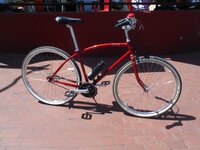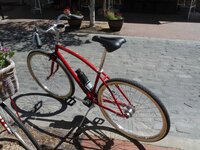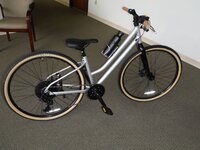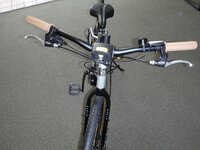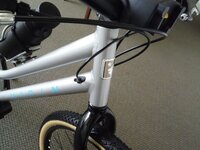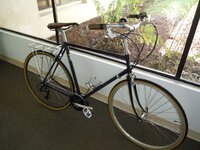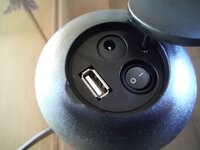I'm finding that the torque sensor of my RipCurrent is just not helpful enough when trying to accelerate from a stop in a low gear, going at slower speeds in a low or middle gear on slightly uphill ground, and especially going up steeper hills. I was finding that I have to use the throttle every time going up moderate hills even at assist level 3. It seems to only kick in very noticeably when in a higher gear at higher speeds. I've switched over to the cadence sensor and it really makes a difference for these situations even at a lower assist level. I guess the torque sensor is great if you really want to work hard and get a bigger workout or if you're riding consistently at high speed (20mph+).
You are using an out of date browser. It may not display this or other websites correctly.
You should upgrade or use an alternative browser.
You should upgrade or use an alternative browser.
Torque sensor seems optimized for higher gears
- Thread starter rjp7
- Start date
rich c
Well-Known Member
That surprises me. Current to the motor is current. It shouldn't make a difference where the controller gets the signal from. My Haibike mtb with Bosch power gets instant response at the pedals from the torque sensor and waiting for some amount of rotation of the crank for the cadence sensor to send a signal would mean I'd be on the ground. Speed on that torque sensor makes no difference. Must be programming of your controller.
theemartymac
Well-Known Member
There may be a setting that determines the torque sensor outputs at varying pressures. Does your manual indicate any programmability? If not, maybe email Juices and see if they can help you adjust the torque sensor sensitivity so it ramps up with less pressure.
My RC torque sensing is about the same as you explain. I don't find it to be a problem but actually a blessing. If you didn't have a throttle to add some assistance that would be different matter. I returned a beautiful e-bike (mid-drive) because the torque sensing assist at low speed was way too much. It sped me up so much I had to stop peddling. Lots of surging. Better to be able add a bit more assistance if needed with the throttle when needed.
@rjp7 After riding an ebike with cadence sensor only for a few years, I had a similar negative first reaction to the torque sensor when purchased CCS2. As you mentioned, torque sensor seems to deliver more power at higher gears. Seems counter intuitive to switch to a higher gear when going uphill, but actually requires less effort, and gets you up the hill much faster as a bonus. I too tried switching to cadence only but found that it was fine tuned to work with torque sensor and overly sensitive such that bike would surge with slightest involuntary movement of peddle, like even when coasting. I am a torque sensor convert now. Just takes some time learning the bike and playing around with the appropriate gear/assist level for a particular scenario. Plus as mentioned, throttle can always add that extra boost as necessary. Cheers.
Last edited:
PedalUma
Well-Known Member
- Region
- USA
- City
- Petaluma, CA
Roll the bike backwards when starting it. Does that sound silly? Imagine a kitchen scale that allows you to weigh strawberries in a bowl. Set the bowl on the scale and turn it on. It will show a weight of Zero. Rolling the bike backwards will set the tare weight on the torque sensor to a negative number making for easier pedaling. But if you start your bike with your foot stepping down, that is really bad. You would then need to get beyond that weight of pedal pressure before getting any assistance from the motor. I will bet that is exactly what you have been doing.
Interesting. I remember seeing something somewhere from Juiced that turning on the bike with foot pressure on pedal could have negative impact on torque sensor calibration for that ride. Rolling bike backwards does sound a bit silly, but certainly will make for an interesting experiment to boost torque calibration. Cheers.Roll the bike backwards when starting it. Does that sound silly? Imagine a kitchen scale that allows you to weigh strawberries in a bowl. Set the bowl on the scale and turn it on. It will show a weight of Zero. Rolling the bike backwards will set the tare weight on the torque sensor to a negative number making for easier pedaling. But if you start your bike with your foot stepping down, that is really bad. You would then need to get beyond that weight of pedal pressure before getting any assistance from the motor. I will bet that is exactly what you have been doing.
PedalUma
Well-Known Member
- Region
- USA
- City
- Petaluma, CA
Cool.
When I do torque sensor mid-drives with coaster brakes they are very sensitive. If they were not the bike could keep going when your foot is on the brake.
Here is a coaster brake torque sensor bike build. I put the motor between the pedals. The owner has hand issues so stopping with her feet was vital.
When I do torque sensor mid-drives with coaster brakes they are very sensitive. If they were not the bike could keep going when your foot is on the brake.
Here is a coaster brake torque sensor bike build. I put the motor between the pedals. The owner has hand issues so stopping with her feet was vital.
Attachments
Sweet! Would not even identify that as an ebike. You are obviously miles ahead with knowledge and experience. Lends credibility to your "silly" suggestion. Will give it a shot.Cool.
When I do torque sensor mid-drives with coaster brakes they are very sensitive. If they were not the bike could keep going when your foot is on the brake.
Here is a coaster brake torque sensor bike build. I put the motor between the pedals. The owner has hand issues so stopping with her feet was vital.
I do think the controller has caused a slight change. I just replaced it because the brake sensors were not working with the previous one and it's providing a little less assist than before. It made me try experimenting by turning off the torque sensor. I had never tried doing that, and it results in much more help per assist level.That surprises me. Current to the motor is current. It shouldn't make a difference where the controller gets the signal from. My Haibike mtb with Bosch power gets instant response at the pedals from the torque sensor and waiting for some amount of rotation of the crank for the cadence sensor to send a signal would mean I'd be on the ground. Speed on that torque sensor makes no difference. Must be programming of your controller.
I ride in a hilly area and was finding I was needing the throttle just too often. Need it less with the cadence sensor. It's nice to just pedal and the bike does what you want without constantly needing to boost with the throttle..@rjp7 After riding an ebike with cadence sensor only for a few years, I had a similar negative first reaction to the torque sensor when purchased CCS2. As you mentioned, torque sensor seems to deliver more power at higher gears. Seems counter intuitive to switch to a higher gear when going uphill, but actually requires less effort, and gets you up the hill much faster as a bonus. I too tried switching to cadence only but found that it was fine tuned to work with torque sensor and overly sensitive such that bike would surge with slightest involuntary movement of peddle, like even when coasting. I am a torque sensor convert now. Just takes some time learning the bike and playing around with the appropriate gear/assist level for a particular scenario. Plus as mentioned, throttle can always add that extra boost as necessary. Cheers.
Yea I've explored all the settings. There's no way to adjust the pressure per assist level in the bike settings.There may be a setting that determines the torque sensor outputs at varying pressures. Does your manual indicate any programmability? If not, maybe email Juices and see if they can help you adjust the torque sensor sensitivity so it ramps up with less pressure.
PedalUma
Well-Known Member
- Region
- USA
- City
- Petaluma, CA
Thanks! I made this one yesterday. Even the battery wires are inside the frame. No ugly connectors and No zip ties to spoil the build. The hard part was that the rear brake and shifter cables would have been crimped by the motor. I had to reroute them while making them vanish.Sweet! Would not even identify that as an ebike. You are obviously miles ahead with knowledge and experience. Lends credibility to your "silly" suggestion. Will give it a shot.
Turning off the torque sensor will make the bike surge and lurch. There will be lag. When the torque sensor is in the pedals and not the back of the bike it becomes much more responsive and does not need a throttle - it is in your foot like a car.
Attachments
Last edited:
Yes I've noticed the same. If I switch to a higher gear going uphill, it gives more assist. Maybe the higher gear puts more pressure on the sensor giving greater assist. It doesn't make sense though. Why have lower gears? They should better tune the controller for lower gears. Sometimes I just want to ride in a lower gear and go slower, to enjoy the views, but the torque sensor is little help for that.@rjp7 After riding an ebike with cadence sensor only for a few years, I had a similar negative first reaction to the torque sensor when purchased CCS2. As you mentioned, torque sensor seems to deliver more power at higher gears. Seems counter intuitive to switch to a higher gear when going uphill, but actually requires less effort, and gets you up the hill much faster as a bonus. I too tried switching to cadence only but found that it was fine tuned to work with torque sensor and overly sensitive such that bike would surge with slightest involuntary movement of peddle, like even when coasting. I am a torque sensor convert now. Just takes some time learning the bike and playing around with the appropriate gear/assist level for a particular scenario. Plus as mentioned, throttle can always add that extra boost as necessary. Cheers.
john peck
Well-Known Member
i honestly notice no real difference between my now parts bike, CCS with torque sensor & myI'm finding that the torque sensor of my RipCurrent is just not helpful enough when trying to accelerate from a stop in a low gear, going at slower speeds in a low or middle gear on slightly uphill ground, and especially going up steeper hills. I was finding that I have to use the throttle every time going up moderate hills even at assist level 3. It seems to only kick in very noticeably when in a higher gear at higher speeds. I've switched over to the cadence sensor and it really makes a difference for these situations even at a lower assist level. I guess the torque sensor is great if you really want to work hard and get a bigger workout or if you're riding consistently at high speed (20mph+).
current bike without. My feet are my torque sensor..
After further test riding with the cadence sensor, it is actually TOO much power even at low assist levels. I guess I'm trying to find the middle ground. Now I'm finding your recommendation to ride the torque sensor with higher gears is better at finding the sweet spot to get more power (but not too much) that is acceptable to me. So I think I'll just stay in the higher gears and stick with the torque sensor. It definitely is smoother than the cadence.@rjp7 After riding an ebike with cadence sensor only for a few years, I had a similar negative first reaction to the torque sensor when purchased CCS2. As you mentioned, torque sensor seems to deliver more power at higher gears. Seems counter intuitive to switch to a higher gear when going uphill, but actually requires less effort, and gets you up the hill much faster as a bonus. I too tried switching to cadence only but found that it was fine tuned to work with torque sensor and overly sensitive such that bike would surge with slightest involuntary movement of peddle, like even when coasting. I am a torque sensor convert now. Just takes some time learning the bike and playing around with the appropriate gear/assist level for a particular scenario. Plus as mentioned, throttle can always add that extra boost as necessary. Cheers.
PedalUma
Well-Known Member
- Region
- USA
- City
- Petaluma, CA
Is your torque sensor in the crank or at the back of the bike? What is the monitoring rate? Good torque sensors are between the pedals, essentially they are power meters running at 1,000 times per second, measuring with a strain gauge at the primary source and using that signal as the input for a request for power. A decent power meter is $400 plus. Decent mid-drive motors have this feature built in. Sucky bikes have a hub-drive with a strain gauge at the back dropouts which is subjected to dirt and grit and lag. https://www.competitivecyclist.com/...ws.com&utm_campaign=datafeed&utm_term=contentAfter further test riding with the cadence sensor, it is actually TOO much power even at low assist levels. I guess I'm trying to find the middle ground. Now I'm finding your recommendation to ride the torque sensor with higher gears is better at finding the sweet spot to get more power (but not too much) that is acceptable to me. So I think I'll just stay in the higher gears and stick with the torque sensor. It definitely is smoother than the cadence.
This electric bike, yes it is an electric bike, has a mid-drive with a torque sensor in between the pedals, monitoring at 1,000 Hz. It is exactly what superior electric bikes look like when you see one. The battery looks like a water bottle, fitting in the cage. See the connector?
Attachments
Last edited:
Well I posted this in the Juiced Bike section since that's what I have. Mine and I think all Juiced Bikes have rear wheel sensors. I've read it does monitor about 1000 times per second. I won't be buying anything else. Just trying to make the best use of it.Is your torque sensor in the crank or at the back of the bike? What is the monitoring rate? Good torque sensors are between the pedals, essentially they are power meters running at 1,000 times per second, measuring with a strain gauge at the primary source and using that signal as the input for a request for power. A decent power meter is $400 plus. Decent mid-drive motors have this feature built in. Sucky bikes have a hub-drive with a strain gauge at the back dropouts which is subjected to dirt and grit and lag. https://www.competitivecyclist.com/...ws.com&utm_campaign=datafeed&utm_term=content
This electric bike, yes it is an electric bike, has a mid-drive with a torque sensor in between the pedals, monitoring at 1,000 Hz. It is exactly what superior electric bikes look like when you see one. The battery looks like a water bottle, fitting in the cage. See the connector?
Explorer-1
Have bike, will travel
- Region
- USA
- City
- Boston North Shore
Keeping the motor RPM up is important when you need a lot of torque. In your first message you said 'even in assist level 3; i take it you've tried levels 4-S as well?
As a trouble shooting test, watch the Watts on the display and make sure when you need the power, the display does say you are using 700-1000 watts. Sounds like everything is OK here, but a good sanity check might be in order.
Unfortunately most ebikes you can't tune the assist levels for you. This feature seems to be coming to some more general ebikes, as i see it as a builtin feature on the new MagicCycle.
As a trouble shooting test, watch the Watts on the display and make sure when you need the power, the display does say you are using 700-1000 watts. Sounds like everything is OK here, but a good sanity check might be in order.
Unfortunately most ebikes you can't tune the assist levels for you. This feature seems to be coming to some more general ebikes, as i see it as a builtin feature on the new MagicCycle.
PedalUma
Well-Known Member
- Region
- USA
- City
- Petaluma, CA
Another thing to try is to start rolling the bike and to pedal backwards when starting it.
Controllers on torque sensor bikes don't like spikes. That means smooth pedaling technique is the way to go. Focus on pulling back and up with grippy pedals and on pushing forward at the top. Avoid stomping down left and right. When it is right it will feel like swimming with scuba flippers, you will know it when you feel it, it is not like stomp dancing with clod hoppers. The bike will deliver much more power efficiently. Down shift to accelerate and keep cadence high, rev up before shifting up - just like with a sports car or motorcycle. Imagine the sound of a motorcycle accelerating through the gears. That is you. Never lug it. Smooth revs on the total circle of pedaling = No spikes.
Controllers on torque sensor bikes don't like spikes. That means smooth pedaling technique is the way to go. Focus on pulling back and up with grippy pedals and on pushing forward at the top. Avoid stomping down left and right. When it is right it will feel like swimming with scuba flippers, you will know it when you feel it, it is not like stomp dancing with clod hoppers. The bike will deliver much more power efficiently. Down shift to accelerate and keep cadence high, rev up before shifting up - just like with a sports car or motorcycle. Imagine the sound of a motorcycle accelerating through the gears. That is you. Never lug it. Smooth revs on the total circle of pedaling = No spikes.
Last edited:
Similar threads
- Replies
- 15
- Views
- 3K
- Replies
- 29
- Views
- 9K
